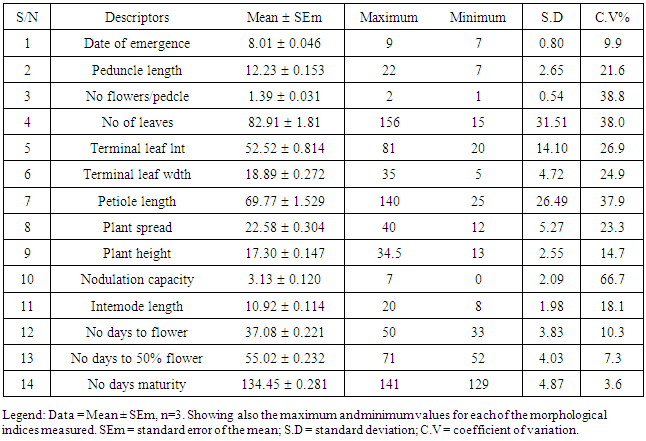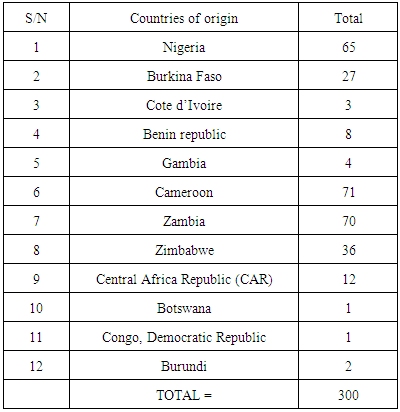-
Paper Information
- Paper Submission
-
Journal Information
- About This Journal
- Editorial Board
- Current Issue
- Archive
- Author Guidelines
- Contact Us
International Journal of Plant Research
p-ISSN: 2163-2596 e-ISSN: 2163-260X
2017; 7(2): 29-35
doi:10.5923/j.plant.20170702.01

Morphological Characterisation of Selected African Accessions of Bambara Groundnut (Vigna subterranea (L.) Verdc.)
John Olayinka Atoyebi1, 2, Olaniyi Oyatomi3, Odutola Osilesi1, Olugbenga Adebawo4, Michael Abberton3
1Department of Biochemistry, Babcock University, Ilisan - Remo, Nigeria
2National Centre for Genetic Resources and Biotechnology (NACGRAB), Moor – Plantation, Ibadan, Nigeria
3Genetic Resources Centre, International Institute of Tropical Agriculture, (IITA), Ibadan, Nigeria
4Department of Biochemistry, Olabisi Onabanjo University, Ikenne - Remo, Nigeria
Correspondence to: John Olayinka Atoyebi, Department of Biochemistry, Babcock University, Ilisan - Remo, Nigeria.
| Email: |  |
Copyright © 2017 Scientific & Academic Publishing. All Rights Reserved.
This work is licensed under the Creative Commons Attribution International License (CC BY).
http://creativecommons.org/licenses/by/4.0/

Three hundred (300) accessions of Bambara groundnut (Vigna subterranea (L.) Verdc) among the 1973 maintained in the global repository at the International Institute of Tropical Agriculture (IITA), Ibadan, genebank were selected for this study. Two to three seeds of each accession were planted during the 2014 / 2015 planting season at IITA, Ibadan, Nigeria. Seedlings were thinned to a single plant prior to flowering. Thirty - seven (37) agro-morphological parameters, representing 28 quantitative and 9 qualitative traits were recorded on each plant (IPGRI, 2000). The data were subjected to analysis using the statistics application system (SAS) software, version 9.3, both to depict correlation among parameters and eigen values with principal component on scree plot and dendrogram construction. The results revealed lines (e.g TVSu – 293, TVSu – 395, TVSu – 1243) that had high yield potentials. Also, TVSu -397 and TVSu – 1168 had the highest number of leaves while TVSu – 520 and TVSu – 1022 had the least. The least number of seeds per plant was given by TVSu – 1, TVSu – 353 and TVSu – 454, while TVSu – 395, TVSu – 618 and TVSu – 1897 gave the highest number of seeds at harvest. The result provides information necessary for future nutrition and breeding studies on Bambara groundnut and its improvement.
Keywords: Bambara groundnut, Agro-morphology, Accessions, Quantitative Parameters, Dendrogram
Cite this paper: John Olayinka Atoyebi, Olaniyi Oyatomi, Odutola Osilesi, Olugbenga Adebawo, Michael Abberton, Morphological Characterisation of Selected African Accessions of Bambara Groundnut (Vigna subterranea (L.) Verdc.), International Journal of Plant Research, Vol. 7 No. 2, 2017, pp. 29-35. doi: 10.5923/j.plant.20170702.01.
Article Outline
1. Introduction
- There is need for the adaptation of agriculture to the changing climatic conditions which will enhance the utilisation and promotion of suitable crops and tree species. These includes the group of under-utilised and neglected species (NUS), as well as the wild relatives of crops (CWR), which all constitute an important tasks for future agricultural practices [12]. Research into NUS is especially important and necessary, due to the need to secure the basis of food production and thus help to provide a balanced nutritional diet for the rural population of many developing countries, like Nigeria, Bukina-faso and Mali in Africa [14]. Important components of agro-biodiversity are the neglected and under-utilised plants (NUS) as these have traits and properties that are important to provide varied and nutritionally balanced diets. These species are often traditionally used, or are wild species that already contribute to a balanced diet, especially for poor people. They also often possess other important properties including the potential to adapt farming to future climates, such as tolerance to biotic and abiotic constraints, medicinal properties, as well as resistance genes against certain pests and diseases, thereby helping to enhance increased food sufficiency through reduced losses, leading to increased production and consumption [14, 17]. Neglected and under-utilised species are comprised of a broad category of agricultural and wild crops in which they exists as either traditional crops that are still being cultivated by farmers or grow as wild vegetables or crops [1, 7, 8]. Here, farmers have an important role to play as custodians of these traditional crops and planting material, as well as for other NUS species and vegetables [12]. However, this responsibility should not only be saddled with farmers alone, but must be supported with other governmental intervention, that will enable profitable policies to benefit the entire value chain of these NUS. Another important stakeholder is the private sector, as they serve as possible ‘engine’ for delivery of these products, especially when it comes to product utilization; thus serving as a possible bridge between the farmers and the consumers. Studies of agro-morphological parameters have been an important approach in exploiting the genetic diversity of crops. This especially makes under-utilised crops more attractive to farmers through identifying appropriate morphotypes and farming practices that can help to determine the choice of germplasm to be used in specific climatic condition studies or in nutrition related research. The creation of options for farmers in the agricultural production system is essential, as it drives the ability of society to address diverse livelihood problems, through the farming system and genetic diversity created; thus enhancing the popularity of such crops for consumption [14]. The sustainable conservation and utilisation of plant genetic diversity and the characterisation of NUS are an important means of achieving food security. The global population grows by an estimated 80 million people a year and is expected to reach 9.2 billion by 2050 [13]. Thus, in preparing for global increases in population, NUS like Bambara groundnut (Vigna subterranea) can serve as a way to address certain deficiencies in the predominant consumption of major crops and diets focused on a limited number of species like rice, wheat and maize; as these NUS possesses the potential to solve numerous nutritional challenges and enhance food security in developing countries. Studies have shown that in West Africa, where most of the Bambara groundnut is being grown, the crop is prominent among the traditionally cultivated food species in rural communities. For example, the crop plays a key role in the traditional food and culture of the people in the western and northern parts of Cote d’Ivoire [17]. Three hundred accessions of Bambara groundnut from different African countries, were selected from the collections at the Genetic Resources Centre (GRC) in the International Institute of Tropical Agriculture, (IITA) in Ibadan, Nigeria.
2. Materials and Methods
- Three hundred (300) accessions of Bambara groundnut (Vigna subterranea), all representing the African accessions in the collection that were domiciled at the Genetic Resources Centre, IITA, Ibadan, Nigeria, (latitude 7° 30 ′ N and longitude 3° 54 ′E). (2-3) seeds of each of the accession were planted during the 2014 / 2015 planting season. Prior to flowering, each accession was thinned to single plants and watered twice a week for the first two months and then reduced to once a week until harvest. According to the Bambara groundnut descriptors, (Bioversity descriptor, 2000), thirty-seven (37) important agro-morphological parameters, representing twenty-eight (28) quantitative traits and nine (9) qualitative ones were taken from the date of planting until harvest. Fourteen (14) important ones out of these parameters were chosen for statistical analysis.
2.1. Statistical Analysis
- Data were analysed using the Statistical Analysis System (SAS) software package version 9.3 to determine the descriptive statistics, one way analysis of variance (ANOVA) and principal component analysis was done with subsequent correlation coefficients utilized to construct a dendrogram so as to view the groupings and relatedness among these collections of Bambara groundnut viz a viz the different yield parameters and their country of origin. Also Microsoft excel 2010 was used for data entry and simple charts.
 | Figure 1. Phenotypic variations among African Bambara groundnut collections |
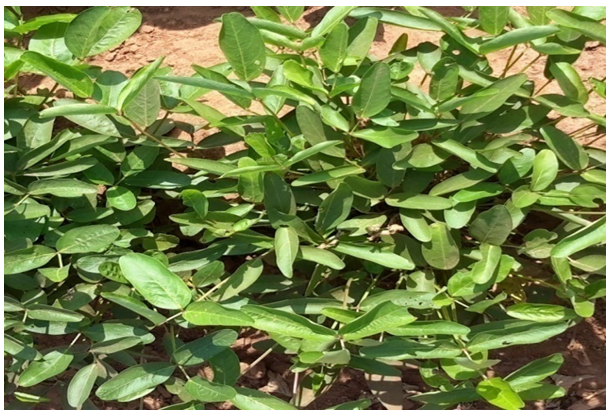 | Figure 2. Bambara groundnut (at 7 weeks growth at IITA, field) |
3. Results and Discussion
- Bambara groundnut is a crop that is widely grown in Nigeria [19]; and other African countries and has become an important NUS. This legume, predominant in sub – Saharan Africa still exhibits immense untapped potentials. The current paper presents research work on agro – morphological performance of 300 African accessions, with the aim of revealing the variability that exists for traits of agricultural importance in this crop with the aim of selection for nutrition parameters and analysis. This will also further aid selection of elite materials in breeding and agricultural improvement programs. From Table 1 shows the mean values of the parametric indices measured; while Table 2 depicts the linear relationship among the chosen parameters. The results of the morphological evaluation revealed mean values for the number of flowers (NFP) to be very few. The number of leaves (NL) had values of wide discrepancies as some were few, while others were numerous, well above 100. The terminal leaf length (TLL) and width (TLW) had scanty and small mean values. The petiole length (PETL) had slightly varied values while those for the plant height (PH) had greater deviations among its values. Also, days to maturity (DM) parameter had a mean value of 134 days for all the collections under evaluation. The results also showed that among all the parameters taken, the number of days to emergence (TDE) had the least variability among its values, while the number of leaves (NL) values exhibited the highest level of variability among its values for the 300 lines evaluated. With respect to inter-relationships among parameters, there was no relationship between the terminal leaf length (TLL) and petiole length (PETL), while the correlation matrix values obtained suggested a relationship between plant height (PH) and peduncle length (PL). There was a positive correlation between the nodulation capacity (NC) and the number of flowers per peduncle (NFP). Among all the yield parameters evaluated across countries of selections, accessions from Cameroon displayed a range in pod length and width from 9.70 mm to 21.0 mm and 8.34 mm to 10.95 mm respectively, while its total seed weight ranged from 0.21g to 5.14 g. Those collections from Nigeria had a range of pod length and width of 10.0 mm to 21.3 mm and 6.0 mm to 14.15mm respectively, while total seed weight ranged from 0.53 g to 3.28 g. The accessions from Zambia gave a range of pod length and width of 9.60 mm to 18.99 mm and 6.70 mm to 10.85 mm respectively, while its total seed weight ranged from 0.25g to 4.25g. Also Zimbabwean accessions gave a range of pod length and width from 9.05 mm to 15.5 mm and 7.09 mm to 12.28 mm respectively, while its total seed weight ranged from 0.20 g to 2.27 g. From the principal components (Fig. 3) and the cluster analysis presented as a dendrogram (Fig. 4) revealed numerous clusters depicting relationships among these collections. It shows that there are at least fifteen main clusters, without counting the numerous sub–clusters and the overlapping ones. Predominant among these were TVSu – 1290 with TVSu – 1284; also TVSu – 1850 showed a close relationship with TVSu – 1789. Furthermore the three clusters showing different groupings for TVSu – 1187, TVSu – 1180; TVSu – 1027, TVSu – 1026; and TVSu – 1262, TVSu – 1243 seemed to be exhibiting the greatest proximity with closest relationships among all the clusters observed, while TVSu – 156 formed its own cluster. The results of this work further indicated the importance of the crop as revealed by its genetic variabilities and performance in the study. The selected 300 accessions in this study could be of immense benefit for the crop in a developing country like Nigeria. The collected African accessions examined indicated qualitative potentials for some lines such as TVSu – 293 (Bukina – Faso); TVSu – 395 (Cameroon) and TVSu – 1243 (Nigeria). Also, TVSu – 397 (Cameroon) and TVSu – 1168 (Bukina – Faso) had the highest number of leaves, while TVSu – 520 (Cameroon) and TVSu – 1022 (Zimbabwe) gave the least. The least number of seeds were given by TVSu – 1 and TVSu – 353 (Nigeria) and TVSu – 454 (Cameroon); while TVSu – 395 (Cameroon), TVSu – 618 (Nigeria) and TVSu – 1897 (Botswana) had the highest number of pods and seeds. The results of this study revealed certain potentials in some of the Bambara groundnut lines evaluated as earlier enumerated, which forms the basis of selection for future nutrition analysis, as well as in breeding and other Bambara groundnut improvement research.
|
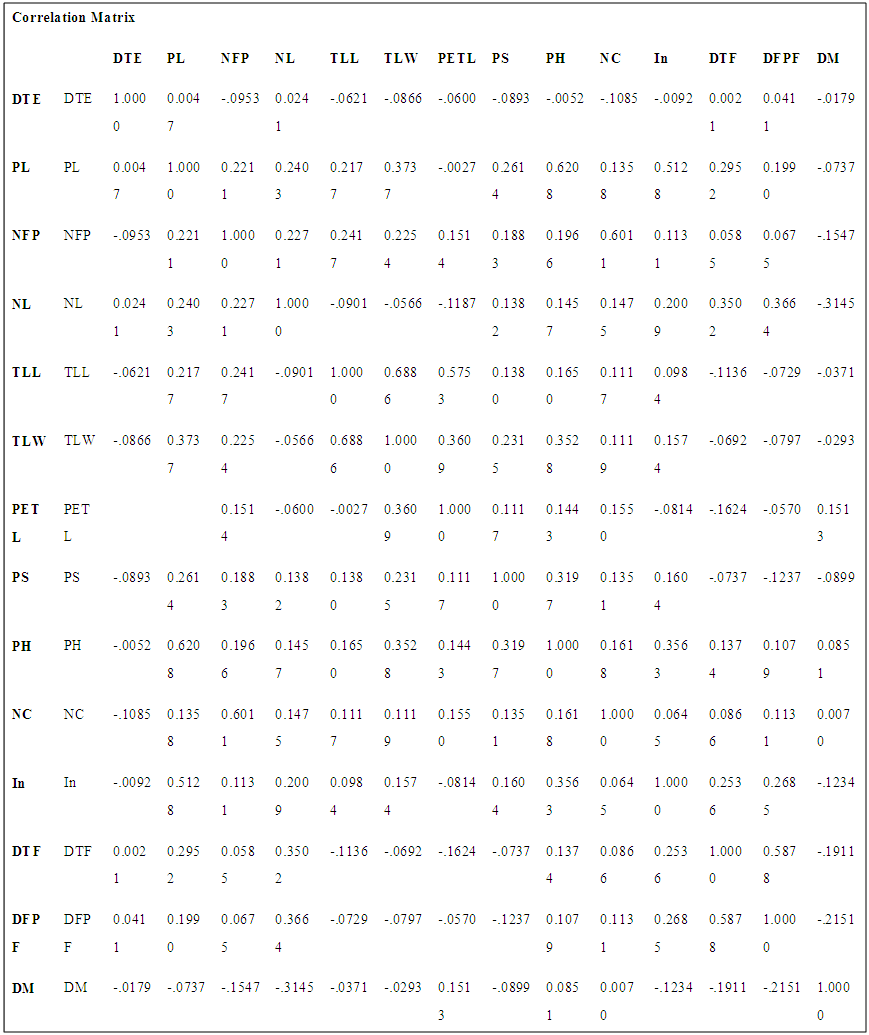 | Table 2. Linear relationships among fourteen morrphological parameters by correlation values |
|
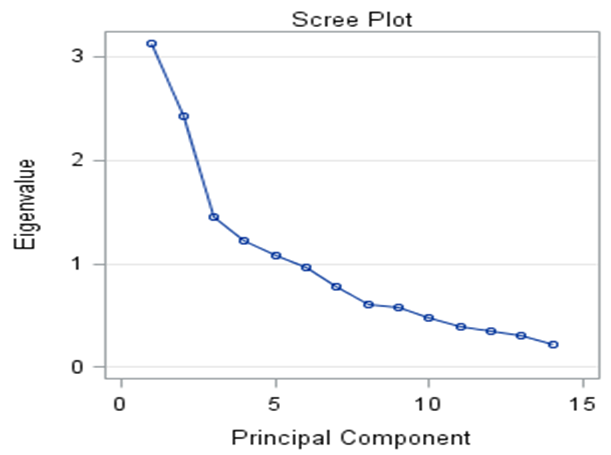 | Figure 3. Showing the Principal Component Plot for selected fourteen parametric indices |
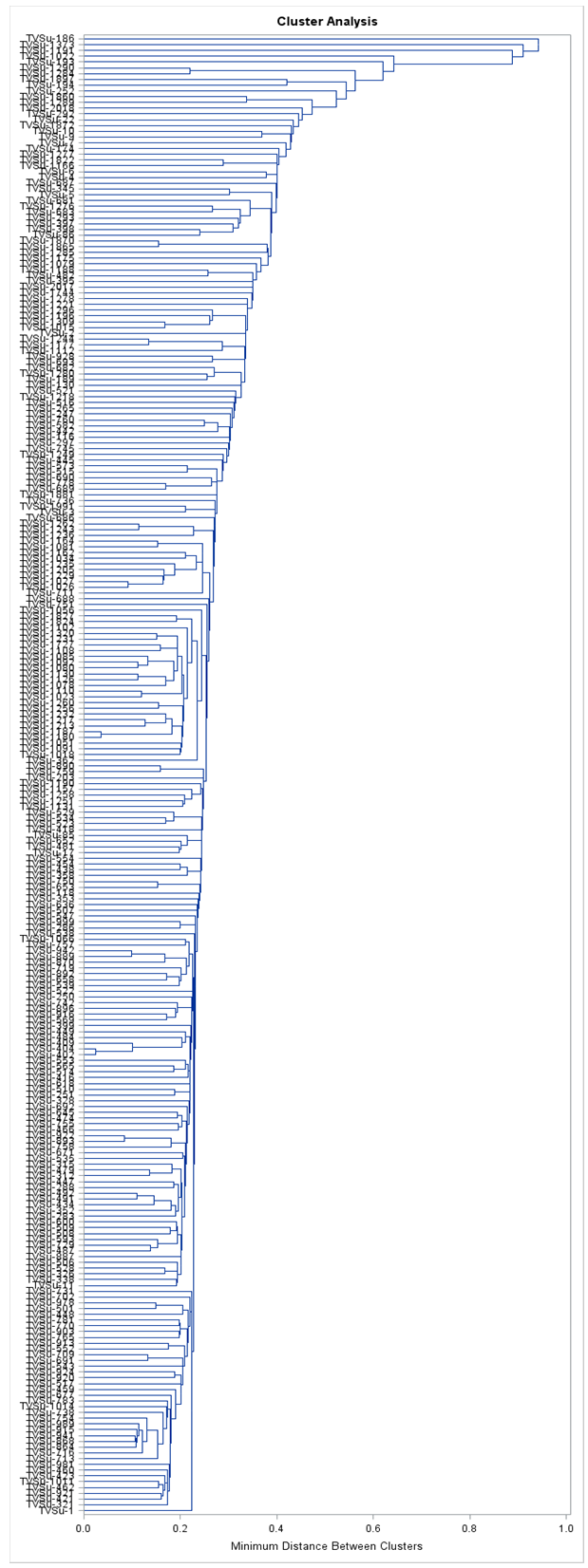 | Figure 4. Cluster analysis revealed as dendrogram for 300 Bambara groundnut accessions |
4. Conclusions
- Bambara groundnut (Vigna subterranea (L.) Verdc.) has a large number of landraces throughout Africa where small-scale farmers have preserved its genetic diversity on-farm. To date, the full genetic diversity of the crop remains largely unexploited [5, 21, 24]. Also there has being little work on its breeding for improved Bambara groundnut varieties at the moment, infact none presently in Nigeria. However, with the results of this work, which further states the importance of the crop as revealed by genetic and agro – morphological descriptors in the study, it serves to form a basis for selection in agricultural improvement programs and nutrition studies in Bambara groundnut. The selected 300 African accessions in this study / research work showed immense benefit of the crop for a developing country like Nigeria specifically and Africa at large. The collected accessions exploited indicated potentials in terms of seed yield for TVSu – 293 (Bukina – faso); TVSu – 395 (Cameroon) and TVSu – 1243 (Nigeria). Also, TVSu – 397 (Cameroon) and TVSu – 1168 (Bukina – faso) has the highest number of leaves, while TVSu – 520 (Cameroon) and TVSu – 1022 (Zimbabwe) gave the least. The least number of seeds was given by TVSu – 1 (Nigeria), TVSu – 353 (Nigeria) and TVSu – 454 (Cameroon); while TVSu – 395 (Cameroon), TVSu – 618 (Nigeria) and TVSu – 1897 (Botswana) has the highest number of pods and seeds. The results of this study agrees with the findings of [12] that despite the numerous potentials in the crop, there is however a need to improve upon its utilisation and market potentials, especially in developing countries of Africa, like Nigeria.
ACKNOWLEDGEMENTS
- The authors like to express acknowledgements to the International Institute of Tropical Agriculture, IITA, Ibadan, for the Graduate fellowship to conduct my PhD research. Also to the entire Genetic Resources Centre (GRC) staff of IITA, Ibadan, Nigeria; and those of Crops for the Future Research Centre (CFFRC), Semenyil, Malaysia campus, especially Dr. Sean Mayes and Dr. Aryo Feldman, for the support of this aspect of my PhD research.
 Abstract
Abstract Reference
Reference Full-Text PDF
Full-Text PDF Full-text HTML
Full-text HTML